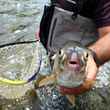I eat trout. I catch them on a fly, grab ‘em in my dry hands, hit ‘em over the head with a rock, and stick the things on a stringer until I leave the water.
Such behavior is heresy in today’s catch-and-release culture, especially coming from a fly fisherman. Just a few weeks ago, I left a lake with my full limit of trout slung over my shoulder, only to be greeted by sneers and a few choice words from fellow fly flingers. I shrugged it off, knowing they wouldn’t be eating as well that night as I would be.
Sarcasm aside, there’s nothing wrong with catching, killing, and eating trout. They taste great, are extremely healthy, and for poor writers such as myself they’re a cheap meal.
But no matter how many times I espouse the virtues of eating trout, I always receive the inevitable, “How can you kill trout?” question.
Here’s my answer.
How many trout do you kill per year? Most anglers will say none. If they practice catch-and-release, they believe every fish returned to the water lives.
That’s just not true. Science backs it up.
According to the Utah Division of Wildlife Resources, nine of 10 fish caught via flies or spinning lures survive after release. However, that’s working on the assumption that anglers properly handle and release the fish they catch.
With all the posing for pictures, fish spend far more time out of water than they should. The #KeepEmWet campaign has done wonders to raise awareness of how important it is to keep fish wet if you intend to release them. But Twitter, Instagram, and Facebook is littered with pictures of fish gasping for air. How many of those trout survive once returned to the water after their photoshoot?
So to everyone who thinks folks who keep trout to eat are nothing but fish-murdering maniacs: there’s trout blood on your hands, too.
I prefer trout blood to be literally on my hands, because that means I’m eating a great meal. Fresh trout is some of the best meat the world has to offer, and I have yet to eat a meal that tastes better than a fat, wild brookie roasted over a fire in the backcountry, cooked and eaten mere minutes after it was caught.
However, it’s important to note here that I’m incredibly selective of where I harvest my fish. Lakes filled with stunted populations of brook trout (the Rockies are full of those) benefit hugely from fish harvest. I rarely keep fish from rivers, unless there’s an effort to restore cutthroat to those streams and biologists have asked for help in removing nonnative species. Almost all of the fish I keep come from lakes and ponds that are either stocked regularly or have ample natural reproduction to support my limited harvest. It’s important to know where to take fish from, because taking them from backcountry lakes with a delicate population can have a drastic impact on the fishery.
Regardless of where you get your trout, the real work is in cooking it. Preparing any kind of meat is an art, and trout takes as much work as steak or prime rib. Over the years, I’ve developed the following system for cooking trout perfectly – every single time. I don’t claim to do many things well in this life, but cooking trout is something I have a knack for.
In fact, my recipe has received perhaps the highest of honors. It’s included in my grandmother’s recipe box. None of my aunts or uncles have recipes in The Box, and when they found out “Spencer’s Trout” recipe made it in, things were a bit hot for a while.
Preparation
Most often, I prefer to eat and cook fillets, for two reasons. One, I can lift the meat right off the bones and not worry about them while eating, and two, I find it easier to obtain optimal seasoning on fillets as opposed to cooking a gutted fish with just the head and tail cut off. However, cooking a gutted fish with the head and tail still attached is also a great way to cook for those who don’t trust their skills with a fillet knife, or prefer to get at the thick meat on the backbone.
For my fillets, I use a standard fillet knife, cut the meat right off the ribs, and lay the fillets in tin foil on a plate. Then gather the following spices and ingredients:
Garlic powder
Sea salt
Black pepper
Lemon pepper or fresh lemons, sliced
Chopped onions (fresh or dried)
Italian seasoning (or green herb(s) of your choice)
Once you have your fillets and seasonings on hand, you’re ready for the trickiest part of this process.
Seasoning
This is where things can go drastically wrong. I’ve ruined my fair share of trout with too much of one spice or too little of another.
If you’re preparing trout for people who don’t like the “fishy taste” of the meat, then I recommend using just a pinch more garlic powder than I do. That helps neutralize the fishy taste, although I like that flavor.
To season a fillet, put the above seasonings on in the following quantities:
A very light sprinkling of garlic powder and sea salt to start. I use maybe a half-teaspoon of garlic powder per fillet – it’s potent stuff. Then I like to sparsely sprinkle salt over the meat.
Grind black pepper over the fillets – as much as you’d like.
Throw in the chopped onions, but do so sparingly. I prefer to use dried chopped onions, and I put enough in to give the fillets a bit of flavor but not to dominate the meat.
Next, a liberal dusting of Italian seasoning. Don’t coat the fillets in the stuff, but make sure that it covers each slice of meat decently.
Finally, sprinkle lemon pepper as desired on top (or place lemon wedges on flesh). This, combined with the garlic powder, helps neutralize the fishy taste, but I just plain like lemon pepper.
Cooking
Wrap the fish in tin foil, completely covering the meat. If you’re using a grill, get it to about 450 degrees and lay the fillets under a closed lid. If you’re cooking in an oven, heat to 350 and place the fillets on a metal baking pan.
The length of cooking depends on the thickness of the fillets, but I generally never cook fish for less than ten minutes. You want the meat to still be moist, but not too moist. Remember, we’re cooking fish here, not preparing sushi.
For my average trout fillet (usually off fish between 17-20 inches) I’ll let them cook around 13-15 minutes.

I like to cook some rice, sauté onions, bell peppers, and garlic in butter and olive oil, then throw the trout on top of the rice with the sautéed peppers and onions.
There are countless ways to cook fish. This is simply my favorite recipe. What’s yours?































Comments
Wayne Weber replied on Permalink
Thank You. I too enjoy trout especially steelhead as they provide a large meal. I am fishing a man made fishery and people can't believe I keep fish. These are the same people that take 20 pictures while dropping the fish on the rocks or in the boat and then let it go. I also only take fish from waters that are stocked or have a population that will support it.
Jeffrey P Reehl replied on Permalink
I too am a fly fisherman who sees nothing wrong in keeping a few trout a year to enjoy it usually make mine in a toaster oven which they still come out tasting tender and delicious, so keep up the great work and tight lines no matter who sneers at you,when I started fly fishing down on the Little Lehigh back in the 70's fisherman used to hide there fly so u wouldn't see what they were using .
Paul replied on Permalink
Keep preaching the good word. There is nothing unethical or immoral with keeping a few trout. To the guys that say you should release all of them...didn't your mother teach you not to play with your food!
tobin replied on Permalink
That's why I like living in east Idaho. Kill and keep rainbows is how the state wants it for cutthroat. While i don't keep 'em all, having some good trout dinners is a good thing.
Anonymous replied on Permalink
Preacher on it, Brother! Like Bill Dance used to say, "Keep what you can use, release the rest".
LOAH replied on Permalink
To the author: I'm with you. People seem to have forgotten that the only reason man started fishing was to feed himself. Of course there are limitless other benefits, but I feel it's important to maintain and respect that original connection.
Now about eating trout: Cooking your way, try Montreal Steak seasoning. You might like it even more than the lemon pepper.
My way: Fillet the fish, remove the skin, dip fillets in beaten egg wash, roll in bread crumbs and grated Parmesan, fry in hot oil.
Paul replied on Permalink
Yum. Thanks for the cooking tips!
Robert Nelson replied on Permalink
roll em in a mixture of half flour and half corn meal and fry em in bacon grease.
Aaron replied on Permalink
I recommend smoking trout, they always come out great. Smoking only takes about 1 hour and is best done with alder chips. The tougher find sometimes is additional alder wood smoking chips, but in today's day in age it is always available online. Consider also a short brine of the trout as well ~1 hour. They are always fantastic and require little consideration in filleting as the meat literally falls off of the bone.
Anonymous replied on Permalink
I love trout it’s the best food in the world .
Pages